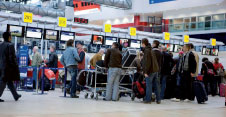
The findings of SITA’s 8th Annual Airport IT Trends Survey state that 53% of airports are planning to increase the number of check-in kiosks available to passengers, while 25% plan to introduce kiosks for new services such as bag tag printing and self-scanning of documents.
The increasing importance of self-service is aptly highlighted by SITA’s 8th Annual Airport IT Trends Survey, which was released in October. The survey, which is based on responses from airport operators representing the views of 198 airports and almost 50% of the global traffic, found that ‘improving customer service’ is the top driver for new technology investments in airports, with 63% considering this their highest priority.
The findings also state that 53% of airports are planning to increase the number of check-in kiosks available to passengers, while 25% plan to introduce kiosks for new services such as bag tag printing and self-scanning of documents. By 2014, 38% of airports will have introduced e-gates for self-boarding, 42% will have e-gates for checkpoints, and 51% will have introduced common-use bag drop locations.
“Automation, including additional self-service applications, will continue to grow in the airport environment simply because technology is the key enabler for a simplified, smooth travel journey,” explained Mayer. “For instance, in the recent SITA Passenger Self-Service Survey, we found that 70% of the passengers interviewed welcome self-boarding and 79% want more airline self-service options, including airport applications.”
This enthusiasm towards self-service from both airport operators and passengers has contributed to the rapid adoption of automated services and facilities throughout the air travel process, which has been driven by the many benefits that are offered.

71% of respondents to SITA's 8th Annual Airport IT Trends Survey said they would implement automated passenger monitoring in different areas of the airport to help reduce congestion and facilitate the integration of required data with multiple systems.
“For the passenger, automation provides options, including control over their travel journey,” Mayer continued. “Whether the passenger wants to check-in via a mobile device, web or kiosk at the airport, or still meet with an agent at the ticket counter, technology has provided the choice. Automation also reduces the time required to perform many processes, including check-in, boarding, verification and access to areas.
“For the airport, automation helps to provide alternative ways to increase throughput without expensive capital investments or construction of new facilities; it helps to reduce congestion.”
Furthermore, Mayer also outlined that automation provides airports with important, accurate data and information, which can be shared in real-time, eliminating the need for manual entries and risk of human error.
Leading IT integration
The main objective of TAV IT is to establish and deliver integrated turnkey airport systems, redefining how an airport is operated by not only providing IT solutions but also increasing awareness and offering new ways of improving efficiency.
TAV IT’s products and services all comply with internationally accepted ITIL, COBIT and ISO standards.
TAV IT’s integrated structure deploys and manages any system and integration in the field of aviation with its own expert teams in: Requirements Management Consultancy; Operating System, Data Storage and Data Base Consultancy; Special Airport Systems Consultancy; IT Service Management Consultancy; Airport CDM Consultancy; Master System Integration; ITIL Consultancy for Airports; and ERP Consultancy for Airports.
TAV IT’s product portfolio of Special Airport Systems includes: Airport Operational Database (TAV IT AODB); Information Broker (TAV IT IB); Flight Information Display System (TAV IT FIDS); Resource Management System (TAV IT RMS); IATA Parser; VIP/CIP Operation & Reservation Suite; and TAV IT Mobile Applications.
TAV IT is constantly developing new products for the industry, and has also recently added to its portfolio customised mobile applications for airports, developed for BlackBerry, iPhone, iPad and Android devices. TAV IT Mobile Applications provide all the information passengers require for a smooth and pleasant trip all conveniently at their fingertips.
TAV IT’s products and services are used in many airports in Europe, Asia and North Africa.
Real-time data

TAV IT’s products and services all comply with internationally accepted ITIL, COBIT and ISO standards.
Having access to real-time information is a vital component of the modern day airport and as well as allowing for increased levels of customer service, particularly through resource optimisation, it can also help to ensure safe and secure operations and achieve operational and business efficiencies.
Mayer added: “Business Intelligence solutions will also enable airports to remain flexible, optimise processes, and make timely decisions throughout all types of operations, even irregular operations.”
According to SITA’s survey, 76% of airports have plans to implement better real-time resource visibility and planning by 2014, and 71% of respondents said they would implement automated passenger monitoring in different areas of the airport to help reduce congestion and facilitate the integration of required data with multiple systems.
“Such collaborative solutions also enable airports to improve customer service by using the information to track service level agreements and key performance indicators,” Mayer said. “For instance, earlier this year, SITA and Copenhagen Airport announced the completion of an automated passenger monitoring pilot, which continues to operate today, providing actionable data to achieve greater operational efficiency and passenger satisfaction.”
Real-time information is a concept that is also central to SITA’s ‘Intelligent Airport’ vision. The Intelligent Airport is essentially an airport that has the ability to track, manage and share real-time information; optimise its processes and decision-making for all stakeholders; and enhance the passenger journey. According to Mayer: “The exciting thing about the Intelligent Airport is that components of it have already been adopted on a widespread basis.”
ARINC’s unique insight
ARINC has provided leading edge solutions to key airport development projects across the Middle East, including Dubai Airport T3/C2 and Cairo TB3 – some of most technologically advanced and integrated airport implementations anywhere in the world. Its experience of these projects, and the current implementation of New Doha International Airport, has given the company unique insight into the evolution of airports across the region.
Whilst such developments will deliver the next generation of enhanced passenger experience, the utilisation of existing airport facilities must be maximised to ease the pressure until new and expanded amenities are completed. Those airports that are, understandably, reluctant to invest heavily in their older facilities can benefit from ARINC’s lower-cost hosted services in which IT applications are run on a remote central server that is linked to client workstations by a secure wide area network.
The vMUSE Enterprise passenger check-in service connects airport check-in agents to ARINC’s Global Processing Center, where they access a virtualised workstation. This enables airports to take advantage of the latest cloud computing technologies and achieve CUPPS compliance without the expense of investing in a whole new set of on-site infrastructure and the skilled staff required to maintain it.
![]()
Smartphone-inspired automation
The ability to harness real-time information has also been aided by the rapid adoption of smartphones among passengers, allowing for new services such as Bluetooth-based passenger tracking, accurate queue measurement and mobile wayfinding. A report released earlier this year by market research firm Parks Associates stated that the number of global smartphone users is expected to increase from the 2010 level of 500 million, to 2 billion by 2015; something that will inevitably impact on the air travel sector.
Mayer said: “Smartphone technology is having the biggest impact on the travel process simply because customised information and activities are available to the user anytime, anywhere. The smartphone enables airports to provide additional passenger services that both augment and improve the journey through the airport.”
“Smartphones are quickly becoming the communication and data device of choice for users in general,” she added, “so airports really have no choice but to continue to invest in these solutions to find new benefits.”







